- /
- /
- /
- /
TVR Tasmin & Wedge Buying Guide
Introduction
TVR cars are relatively inexpensive British sportscars, that are not mass produced or constructed on automated computer controlled production lines. They are mostly hand-built in very small numbers, by a skilled workforce to exact customer’s requirements.
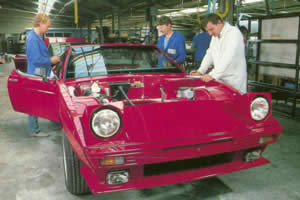

Having said the above, because they are hand-built, the build characteristics and specification of the vehicles can vary across the production runs, and indeed between two consecutive cars. If you are the type of person that is driven ‘up the wall’ by little rattles, squeaks and the occasional bit falling off, then older model TVR ownership possibly isn’t for you.
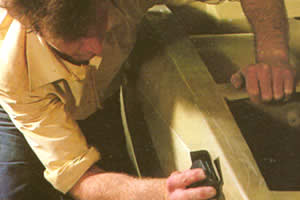
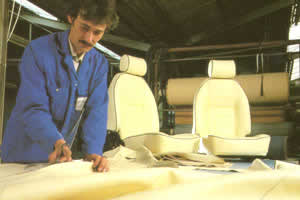
What you will get for your money, is a certain amount of exclusivity, (as only very small numbers of the cars were built), excellent handling, outrageous acceleration and a grin factor of +10!.
It is now over 10 years since the last models were produced. Unless looked after, the cars can deteriorate rapidly (especially the interior) and tend to look tatty very quickly. Fortunately, the majority of the surviving cars that are about today are in the hands of enthusiasts and therefore, tend to be a little better looked after. Although you will still find the occasional dodgy car advertised for sale.
I think it is fair to say that if you buy an older TVR, then you probably will run into some problems (as with any older car). I remember when I test drove a TVR ‘S2’, by the time I had finished the test drive the rear number plate had fallen off, the inside door handle came off in my hand and the throttle had stuck on full during the run! – I still purchased the car though, as the car was basically sound apart from one or two cosmetic issues.
All TVRs have certain quirks and characteristics that you have to live with. When you meet and talk to other owners, you start to get familiar with the terms ‘They all do that’ or ‘Mine does that as well’.
Models
Before charging ahead and buying a wedge, it is a good idea to familiarise yourself with the marque, and try to get as much background information about the various cars as possible. A good idea is to join the TVR car club and attend the various local club meetings, talk to other owners, try to get hands on advice and ask lots of questions.
There are also several good books available; the ‘Wedge Series’ book by Steve Heath contains a lot of useful information. You could also keep checking back to this site, which will grow over time and should build into a useful source of information.
Another thing to decide is what model wedge you intend to invest in, even the 200 and 2.8i Tasmin models are more powerful than any ‘hot hatch’. If you are new to TVR ownership, jumping straight in and buying a four litre Rover V8 fire breathing 400SE might not be too good an idea. These cars demand respect, and require concentration and constant attention whilst driving or you can easily get out of shape – big style!
The original 1980 Tasmin was launched as a two seater coupé, the car featured a Ford V6 ‚Cologne‘ 160bhp powerplant with a long sloping hatchback and a long, low nose with a steeply raked windscreen (series 1).
A convertible model quickly followed as did a +2 fixed head coupé model (although all three were announced at the same time), featuring an additional two (rather small) seats in the back. The +2 also featured a shorter nose than the original Tasmin, new side skirts and a different spoiler arrangement at the front (see 2+2 pic below).

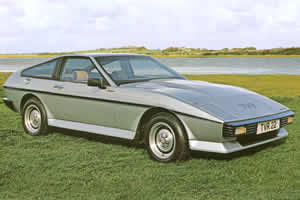
By 1982 Peter Wheeler had taken over the reigns of the factory from Martin Lilley, and shortly after, in an effort to create more sales the cheaper (under £10,000) 2.0-litre four-cylinder Tasmin 200 was launched. This was not as popular as TVR would have hoped, and was phased out of production in 1984.
In an attempt to increase the performance of the V6 cars, TVR developed a turbocharged version of the Ford V6 (228bhp), the Tasmin Turbo. 1983 however, saw a landmark decision by TVR to use the Rover V8 engine in it’s cars.
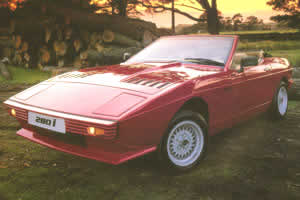
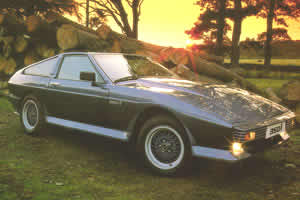
The 190bhp V8 engine used by Rover was ‘shoe horned’ into the Tasmin chassis, producing the Tasmin 350i (later on the ‘Tasmin’ name was dropped). Significant changes had to be made to the chassis to fit the Rover engine, but once put into production, the 350i became the best selling model in the TVR range. At around the same time, the Ford engined cars were also renamed 280i (see pic above).


In Autumn 1984, the 390SE was introduced (SE standing for Special Equipment). This car had an enhanced 275bhp V8 fitted ‘bored out’ to 3,905cc, and had improved performance over the 350i. The car also featured a much deeper front air-dam spoiler and a rear under-body aerofoil as well as other special options fitted. The 390 unfortunately was only produced in relatively small numbers and can sometimes be very hard to find on the used car market. When new, the car also cost approximately 30% more than the standard 350i model.
By 1985, subtle changes to the bodywork made the car more rounded (series 2). In 1986, TVR also revised the rear ‘trailing arm’ suspension setup to an improved ‘A’ frame system, which improved road handling.
In 1986, TVR launched the 300bhp 420SEAC (see pic below), SEAC standing for: Special Equipment, Aramid, Composite. The car featured a body made of a lightweight Kevlar composite honeycomb material (although some later SEACs were also known to be produced with standard fibreglass GRP bodies – check this when viewing).

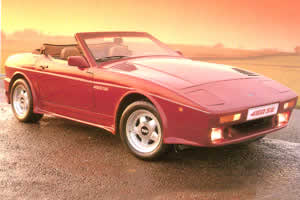
The SEAC styling was a lot less ‘angular’ than the 390/350 and the SEAC became the most rounded looking wedge produced. Many were also fitted with a rather large boot spoiler that may, or may not be to your particular taste.
By 1988, the fettled 324bhp 450SEAC became the top of the TVR range. In this year the 280i series cars were also discontinued.
Another significant launch in 1988 was the 400SE. The 275bhp V8 400SE featured a ‘wraparound’ re-styled cockpit and various other bodywork and styling improvements. In my humble opinion, the 400 series were the best looking and the better of all the wedge cars.
In 1989 the 450SE version was launched (see pic above right) and sported a monstrous 320bhp 4441cc alloy V8. Only a very small quantity of the 450 cars were produced, and are consequently much sought after by collectors and are therefore, very hard to find. The wedge series continued in production until 1991, to be replaced by the new curvaceous TVR Griffith.
Several other more ‘special’ models of wedge cars were produced with different engine sizes, turbocharger options or different body specs, but these are almost impossible to find for sale.
You should also be aware that specs and equipment changed over the production of the wedges quite considerably and over the years owners may have made various styling modifications themselves.


Some cars have may have PAS, wooden steering wheels, heated seats, air conditioning, roll-over bars, electric mirrors etc. It is also not uncommon to have completely different alloys, full leather interior options, upgraded engines or different spoilers. Each car is different and must be taken on it’s own merits.
Availability
Once you have decided the model you are interested in, the next thing is to find one. You will find these cars for sale all over the Internet, you will also find a selection in the TVR Car Club ‘Sprint’ magazine or website and in motor magazines such as ‘Top Marques’.
You will probably not find any wedge cars for sale in ‚mainstream‘ car dealerships, as these tend to shy away from these cars in the same way that they tend to avoid manufacturers like LOTUS; it is not that they don’t like them, but simply they don’t understand them. One of the reasons being TVRs, especially older models don’t feature in the price ‚bibles‘ that car traders tend to use as reference, and are therefore considered ‚quantity X‘.
These days you will also be hard pushed to find any of the wedge series cars in any of the main franchised TVR dealers forcourts. There are however a handful of specialist dealers that may have a number. Dealers offer the benefit of warranties, finance deals and trade-ins for your old car, although the price will obviously be higher than if you were buying private. A shrewd move is to wait until winter to start looking, there are always more cars for sale at this time and the prices do tend to be a little lower.
Another good rule to follow is the later the car you intend to purchase (or can afford) the better it should be (theoretically). Early production changes and ‘fettling’ at the factory would have been sorted, and the production run would have settled down. Try looking at a 350i and a 400SE next to each other, the evolution of the model can be clearly seen.
Try to also look for a TVR service logbook with main dealer stamps or any other relevant ‘history’ documentation. As with ‘normal’ cars, this is a good omen if it has been looked after by the previous owners. You should be a little suspicious of cars with no service logbook, no dealer service stamps or previous history at all.
A HPI check can also be a useful investment, costing around £15, the check could bring to light any sinister information about the car, not to mention if it has any finance left on it. HPI can be contacted on the web at this address: http://www.hpi.co.uk. You could also get a local TVR dealership to give the car a once over for you. You will probably have to pay for this, but a small outlay of cash now, might save a much larger one later!
Low mileage cars might not be too good a thing either, these cars are meant to be used. Cars that are left for long periods can suffer from all sorts of problems which could prove expensive to put right at a later date. Test drive as many cars as you can before making a decision – don’t buy the first car you see. The danger is that as soon as the acceleration and noise hits you, the ‚rose tinted glasses‘ go on, try to think rationally (well, it is a sportscar!) and try to evaluate the car in the cold light of day compared to the others that you have seen.
Car prices generally in the motor trade have fallen quite considerably over the last few years and at the moment it is a buyers market. Make an offer, you never know….If you do get one (whatever model) as soon as you accelerate down the road for the first time you will experiance the ‚TVR Grin‘!
The Interior
The cockpit design and dash layout changed several times during the production of the wedges, the later cars having a more rounded look to the dash.
Because TVRs are bespoke, many design and colour combinations can be found. The customer could specify what colour leather, stitching, pipeing, inserts and dash top he or she wanted. The customer also had the choice of full-hide, half-hide and Cloth coverings and what colour carpets. Obviously with such a wide choice you can come across some that are not so ‚hot‘, I have see orange carpets in one example!
Leather seats and coverings should be checked for rips, tears, cracks and water damage (from leaky hoods or windows). The upholstery can be totally replaced or repaired by specialists.


The walnut dash panels (see above) and door trim caps are also prone to fading, cracking and chipping and are quite expensive to replace.
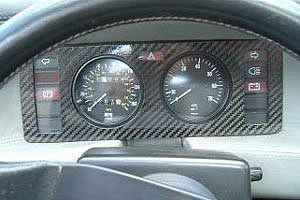

I have seen some cars ‘retro fitted’ with brushed aluminium or carbon fibre replacements as above right. Some look quite good but again, depends on what your taste is.
Electrics
The electrical systems on all wedges can be a little ‘temperamental’. The TVR wiring colour codes are sometimes misleading, and figuring out which wire goes where can be a bit of an odyssey. Part of the trouble is, everything requires an earth wire and therefore, has twice the probability of breaking or coming adrift somewhere along the line.
Whilst inspecting a potential purchase, check every switch and electrical item works. Pay attention to the lift motors on the main headlights (TR7 based), the lift motors for the electric windows, the electric aerial and central locking (if fitted), the engine cooling fan and the internal heating fans. All of which can be quite expensive to diagnose, fix or replace.
When I got my 350i home, on prolonged inspection I pulled out three alarms, two immobilisers and about 20 foot of wire – all of which were not connected to anything!
Water Ingress
Most TVRs leak in some shape. The top of the windows, through the hood material itself, roof seals and any engine bay bulkhead cable holes are the main areas. You should check for water damage to the seats and carpets. The footwell or boot carpets might be rotten, but can be replaced (see pic below). A full re-trim will obviously cost a lot more, but can be done.

 The seals should be checked on the roof piece and around the doors for damage or signs of perishing (pic above right). They can also be replaced, but is a fiddly job involving a lot of adhesive and patience.
The seals should be checked on the roof piece and around the doors for damage or signs of perishing (pic above right). They can also be replaced, but is a fiddly job involving a lot of adhesive and patience.
Bodywork
Most TVRs including the wedge series are made of GRP fibreglass (although a handful of SEACS were made from a carbon fibre composite). This obviously does not rust, but because of the sharp corners and acute angles of the body design, can suffer from a number of other problems.
The most common is ‘rippling’ of the fibreglass. This has the appearance of a slightly uneven look to the bodywork, this in itself, is not really a problem it just slightly spoils the finish of the car.
Another common fibreglass problem is ‘stress cracks’. These appear around areas of acute angles (around the headlight openings etc). The bodywork is separate from the load bearing chassis so these cracks are not a problem, but again can spoil the appearance of the car.
The front end of the cars and the wheel arch areas can also take a bashing from stone chips etc. I have even seen severe stone chip damage on the stone chip protector on a 400SE! (see pic below).

 The lower spoiler on the wedges are also prone to either being grounded on something like a speed bump or kerb, and have quite a hard life (see pic above). Replacement panels are available from companies like TET Mouldings which are quite inexpensive, but can be a little costly to have replaced and re-painted as well. The rest of the bodywork should be relatively smooth, any undue bumps or bulges could mean a repair at some time or other.
The lower spoiler on the wedges are also prone to either being grounded on something like a speed bump or kerb, and have quite a hard life (see pic above). Replacement panels are available from companies like TET Mouldings which are quite inexpensive, but can be a little costly to have replaced and re-painted as well. The rest of the bodywork should be relatively smooth, any undue bumps or bulges could mean a repair at some time or other.
Windows
The front windscreens on the wedge models are TVR specials. Stone chips or deep scratches should be carefully checked to see if it warrants a new screen.
Another common issue with TVR windscreens is that water gets in between the glass laminates and causes a white stain (de-lamination). You cannot get rid of this and replacement is the cure (see pic below). I have seen some cars which have had black stripes or paint over the affected areas of the screen. If you come across this, it is more than likely that the screen has this problem.


The plastic rear hood window on the convertible models is also quite costly to replace (as is the rest of the hood). You should check this for rips, tears, cracks or ‘frosting’ i.e. where the window has started to go opaque. The glass rear window on the fixed head coupe wedges is also notoriously hard to locate and can be extremely expensive, although I think more are to be found now, thanks to the Tasmin Challenge boys and girls.
The electric window wind motors are usually very slow in operation and are also prone to wear, especially on the driver’s side. You should check these are fully operational and the runners are straight.
Chassis
The chassis is TVR designed and made of a tubular steel, welded space frame (with outriggers). It is covered with a plastic powder coating for corrosion protection. The coating comes in several colours but whatever the colour, it probably would have started to peel off by now. Water and road muck gets under the coating and rusts the steel tubing and joints from the inside.

The underside of the car should be inspected thoroughly (preferably on a garage ramp). There are many places on the chassis that get a pasting off stones, mud, water and other road debris (see diagram). Surface rust can be cleaned off, painted with ‘hammerite’ and then ‘waxoyled’. I know of several owners that have taken the drastic step of a full body-off chassis renovation.
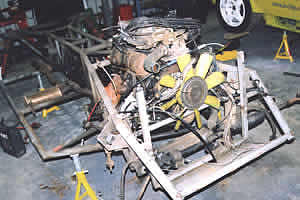
 The chassis outriggers also get a fair amount of exposure to the elements and should also be checked for excessive corrosion (although this can be very difficult without taking off the GRP sills). I have seen some that have resembled Swiss cheese on 1989 registered cars. Also be wary of any obvious chassis damage, bent tubing or recent welding. This could mean that the car has had some impact damage in its life.
The chassis outriggers also get a fair amount of exposure to the elements and should also be checked for excessive corrosion (although this can be very difficult without taking off the GRP sills). I have seen some that have resembled Swiss cheese on 1989 registered cars. Also be wary of any obvious chassis damage, bent tubing or recent welding. This could mean that the car has had some impact damage in its life.
Engine
The engines on the 200, 280i and 350i are pretty much standard Ford and Rover units. The larger capacity engines although tuned to give more power have also been modified by TVR Power to enhance the output. Parts for the engines themselves are relatively common. You should be a little suspicious about engine modifications that the previous owners have had carried out on the car, and you should investigate such modifications in detail.
Exhaust Systems
Wedge exhaust systems are TVR specials and are quite expensive (although you can have a stainless bespoke system made by several independent sources). You should check the general condition of the exhaust system thoroughly, especially the manifolds and down pipes.
The wedge series cars (especially the big V8’s) are among the loudest TVRs made – don’t buy one if you like to arrive un-announced. If you intend to take the car on track day’s etc, you probably won’t pass the noise test to even get on the track. Mine didn’t at Castle Combe and I know several other owners of wedges who also didn’t pass. You can get silencer inserts to help reduce the noise, but even with these you cannot guarantee that you will pass a track noise test.
Another issue that you might want to bear in mind is how well you get on with your neighbours. My car sets off car alarms as you drive by, and has to date caused several disputes, especially with early morning starts or returning late evening and waking the entire street!
Cooling system
Large engines in plastic cars always have a problem with heat dissipation. The large amount of heat generated by the engine block has to be dissipated. If the cooling system is not in tip-top condition the engine can overheat and cause all sorts of scary damage. On a test drive it is important to check the operation of the engine-cooling fan – leave the car running and wait for the fan to kick in (and turn back off again). Some owners have fitted a fan override switch to facilitate early activation on the fan in such conditions as traffic jams etc.
Brakes
Brakes on all the wedge cars (except maybe the later 400 / 450’s) are not so good. ABS was never fitted to any of the cars. Check to see if the disks are worn or warped (brake judder) and check the brake system throughly for any brake fluid leaks. There are several specialists that offer brake upgrades and conversions. The upgrades range from fitting race / fast road pads to bigger ventilated disks, braided brake hoses and four pot callipers. You can attemp this yourself if you feel brave enough.
veröffentlicht 2004 auf tvrwedgepages.co.uk
